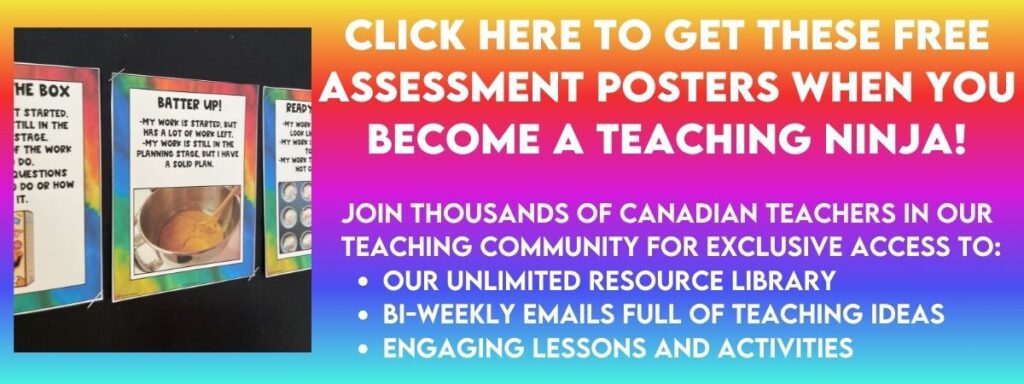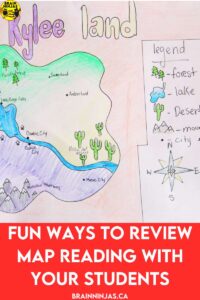
Every year, we have to practice map reading with our students. Some skills stick, but others evaporate over the summer. Even with all the technology of Google Maps and other apps, students still need basic map reading skills. Learn how we review (or teach) geography skills and use a fun project to show off what students have learned.
Start With the Basics
We have a whole map reading resource that we use with our students. The maps are fictional (and kind of fun). It covers each skill with a simple map and includes an assessment. There’s even a review activity and assessment along with a final project. We use this resource every single year (usually during the first month of school). Find the Map Reading Skills Resource on TpT ($USD) or our BN Shop ($USD).
Before students can get too far into map reading, they need a few basic skills. For example, the title of a map will be the largest print. The font size reduces for each level.
Here’s an example using a map of Canada. The country name (Canada) will have the largest font. Provinces and territories will have the next size down. Towns, rivers or counties will have an even smaller font. Oceans might have a larger font while bays, gulfs and rivers would be smaller.
By knowing the font size, students can find the most important information right away. They can also use this skill when they create their maps.
Directionally Challenged?
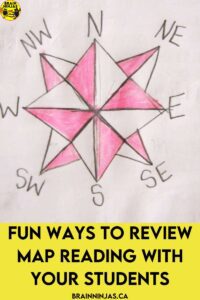
So many of our students mix up the directions. Even as an adult, I have to think “never eat shredded wheat” to remember the directions. It helps students to review the cardinal (north, east, south, west) and intermediate (northwest, northeast, southwest, southeast) directions. This could be simple, like drawing a compass and labelling the directions. You could make a simple anchor chart. Or, you could label the actual directions in your classroom.
Play a game to learn about directions.
Materials: compass, a pylon or marker, direction page for each team
Divide your group into teams of 3 students each.
Before playing, you’ll need to create a directions sheet. You will need to create directions that lead back to the starting position so you know they have followed the directions correctly. A direction sheet might look something like this:
- Take 5 steps south.
- Take 10 steps east.
- Take 20 steps north.
- Take 15 steps west.
- Take 15 steps south.
- Take 5 steps east.
We recommend doing this activity outside or in a gymnasium where they have plenty of room.
Reading Legends
Most students find reading a legend fairly easy when they remember to look at it. Legends are used in many places including maps. Flip through a social studies or science textbook to show students examples of legends in different places.
Longitude and Latitude
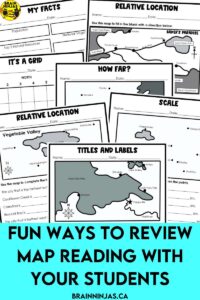
Not all maps include longitude or latitude lines, but if you have a globe, show students the light blue lines all over it. Most students understand GPS (global positioning system). Explain that GPS uses longitude and latitude to find positions on the globe. This means every single place on the planet has coordinates. This makes pinpointing specific locations easy.
You can show students these coordinates using the site https://www.latlong.net/. Put in your location and find the coordinates.
Play a game. Give students longitude and latitude coordinates and a map. Have them race to find the location as fast as possible. Students can find coordinates for each other and then challenge each other to find the locations.
Create a Map of Your Students
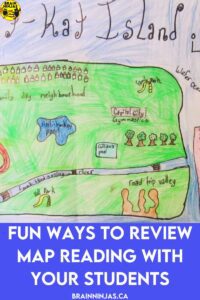
Once we reviewed all the map-reading skills, students got to put their creative map-making skills to use. We ask students to create their own map, but all the features on the map tell us about who they are. This is a great activity during the first of the month of school. You get to know your students, see what they know and review map reading. Even better, you have a great bulletin board created by your students.
We have outlined this project in detail in our Map Reading Skills Resource available on TpT ($USD) or our BN Shop ($USD). The project includes planning pages and checklists for students. There is a rubric for teachers. There are even a few follow-up activities.
Your students may need some help to self-assess their work. We get asked “is this good enough?” a lot. To stop this constant question, we created the cupcake scale. It’s a simple system for students to self-assess whether or not their work is ready to hand in. We’ll send the cupcake assessment scale to you for free when you sign up for our email list. If you’re already on the list, find it in the Resource Library.
Other Ways to Practice Map Reading
Map out a setting for a story or fairy tale.
Create a map of your community. We created a whole resource around creating simple maps called Map Quest. It’s a fictional activity where students have been hired to replace all the maps in the world. Find Map Quest on TpT ($USD) or our BN Shop ($CAN).
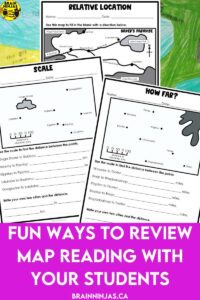
Create a set of instructions to lead someone through a journey on a map.
Create a course in your room. Map it. Drive a Sphero or other codable robot through the course.
Create a map skills anchor chart. This activity is included in our Map Reading Skills resource on TpT ($USD) or our BN Shop ($USD).
Using a world map, find the locations of your favourite books, television shows or movies.
Create a topographical map using air-dry clay or dough. There are lots of recipes online to make dough using salt or cornstarch, but they take time to create. Have parent volunteers make the dough or ask to purchase the materials.
Complete a geography scavenger hunt. We already created hunts for Canada (and for all of the provinces and territories). You can learn more in our post Disguise Research Skills as a Scavenger Hunt.
Map out a travel route for the ultimate vacation.
Do You Teach Social Studies?
If you teaching social studies in Canada, you might find these posts helpful:
- How to Teach Multiple Perspectives in the Classroom
- How to Bring Social Studies Lessons to Life
- How to Take Your History Lessons Off Life Support
What do you like to do when teaching students map skills? Leave us a comment about your favourite geography activity.

